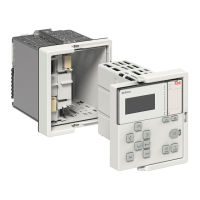8.2.2 Checking CT circuits
Check that the wiring is in strict accordance with the supplied
connection diagram.
The CTs must be connected in accordance with the terminal diagram provided with
the protection relay, both with regards to phases and polarity. The following tests
are recommended for every primary CT or CT core connected to the protection
relay.
• Primary injection test to verify the current ratio of the CT, the correct wiring
up to the protection relay and correct phase sequence connection (that is L1,
L2, L3.)
• Polarity check to prove that the predicted direction of the secondary current
flow is correct for a given direction of the primary current flow. This is an
essential test for the proper operation of the directional function, protection or
measurement in the protection relay.
• CT secondary loop resistance measurement to confirm that the current
transformer secondary loop DC resistance is within specification and that there
are no high resistance joints in the CT winding or wiring.
• CT excitation test to ensure that the correct core in the CT is connected to the
protection relay. Normally only a few points along the excitation curve are
checked to ensure that there are no wiring errors in the system, for example,
due to a mistake in connecting the CT's measurement core to the protection
relay.
• CT excitation test to ensure that the CT is of the correct accuracy rating and
that there are no short circuited turns in the CT windings. Manufacturer's
design curves should be available for the CT to compare the actual results.
• Earthing check of the individual CT secondary circuits to verify that each
three-phase set of main CTs is properly connected to the station earth and only
at one electrical point.
• Insulation resistance check.
• Phase identification of CT shall be made.
Both the primary and the secondary sides must be disconnected
from the line and the protection relay when plotting the excitation
characteristics.
If the CT secondary circuit is opened or its earth connection is
missing or removed without the CT primary being de-energized
first, dangerous voltages may be produced. This can be lethal and
cause damage to the insulation. The re-energizing of the CT
primary should be prohibited as long as the CT secondary is open
or unearthed.
Section 8 2NGA000823 A
Commissioning
68 REX610
Operation Manual

